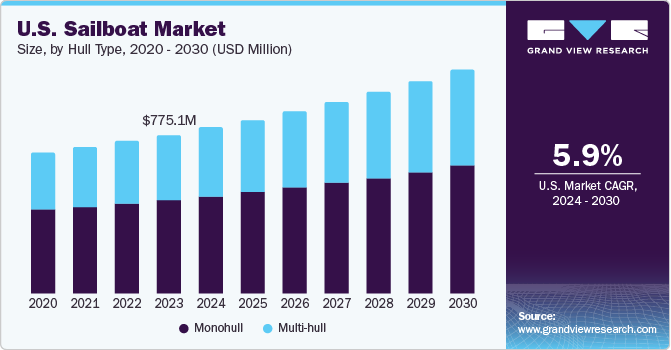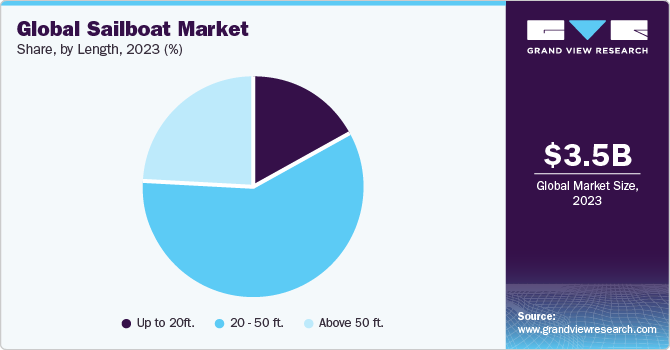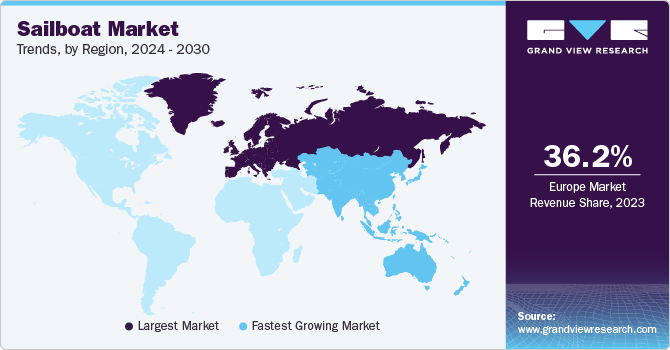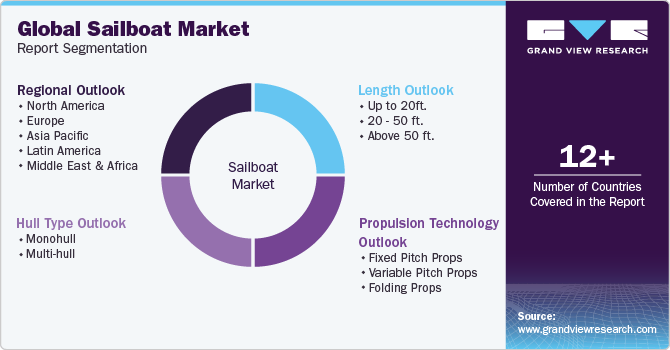
Sailboat Market Size, Share & Trends Analysis Report By Hull Type (Monohull, Multi-hull), By Length (Up to 20ft., 20-50 ft., Above 50 ft.), By Propulsion Technology (Variable, Fixed, Folding), By Region, And Segment Forecasts, 2024 - 2030
- Report ID: GVR-4-68038-364-5
- Number of Report Pages: 104
- Format: PDF, Horizon Databook
- Historical Range: 2017 - 2021
- Forecast Period: 2023 - 2030
- Industry: Technology
Sailboat Market Size & Trends
The global sailboat market size was estimated at USD 3,467.3 million in 2023 and is expected to grow at a compound annual growth rate (CAGR) of 4.9% from 2024 to 2030. The market has experienced a positive growth trajectory due to an increase in disposable income levels, expanding its appeal to a wider demographic. Fluctuations in economic conditions, such as interest rate variations and shifts in consumer confidence, can significantly impact purchase decisions within this sector. With the growing environmental consciousness, there is an increasing demand for environmentally sustainable sailboats.

Manufacturers are actively allocating resources to R&D to create product designs that are both sustainable and efficient, integrating elements, such as electric propulsion and renewable energy sources. Global industry has been profoundly influenced by various technological advancements, leading to notable improvements in sailboat construction and navigation systems. Innovations, such as automated sail controls and advanced navigation aids, have enriched the overall sailing experience. Furthermore, stringent environmental regulations, particularly those pertaining to emissions and waste management, have driven manufacturers to adopt cleaner production techniques and materials in their operations.
Market Concentration & Characteristics
The level of innovation in the sailboat industry is usually considered as moderate. Although constant efforts are made to improve sailboat performance, materials, and designs, innovation is not occurring at the same rate as in many other industries. Manufacturers frequently concentrate on enhancing energy efficiency, perfecting current technology, and optimizing sail designs. Increased performance and durability are a result of innovations in hull design and materials, but industry priorities tend to favor evolutionary rather than revolutionary advances. By balancing proven design principles with a reasonable level of innovation, manufacturers are able to meet customer expectations for dependable and sophisticated sailboats.

Although partnerships, mergers, and acquisitions do occasionally happen in the industry, they do not happen as regularly as they do in more dynamic regions. Businesses may work together to share resources, broaden their customer base, or take advantage of synergies, but the sailboat industry is still typified by a wide range of independent producers and smaller businesses. The industry landscape is characterized by a moderate level of M&A activity and a tendency for companies to give priority to organic growth and product development over large-scale corporate transactions.
Regulations have a medium impact on the market. Regulations pertaining to environmental factors, safety standards, and sailboat navigation are usually set by governments. The aforementioned restrictions are designed to safeguard the welfare of travelers, preserve the environment, and uphold equitable competition in the sector. Although it is imperative to comply, the regulatory framework is not too burdensome, enabling manufacturers to function within prescribed parameters without substantial obstacles to entry. Businesses can operate in the market with a fair amount of flexibility while still upholding crucial environmental and safety requirements thanks to the regulations' moderate impact.
In the sailboat market, product alternatives are somewhat common. While sailing on a sailboat is a unique and peaceful experience, those who are looking for other aquatic adventures can go for motorized boats, yachts, or personal watercrafts as an alternative. The availability of these substitutes makes it difficult for sailboat producers to set themselves apart from the competition and highlight the special advantages of sailing. In order to stay competitive, businesses frequently concentrate on promoting the inherent benefits of sailing, like the excitement of wind-powered travel, the sense of independence that sailboats offer, and the connection with nature.
In the sailboat industry, end-user concentration is moderate and includes a wide range of customers, from professional sailors and charter firms to leisure sailors and sailing enthusiasts. Although there isn't a single demography that controls the market, producers still need to cater to the diverse wants and tastes of many customer categories. The significance of providing a variety of sailboat models with a range of features and pricing ranges to appeal to a wide client base is highlighted by this moderate end-user concentration. To maintain an edge in the market, businesses in the sailboat industry must continue to be flexible in response to shifting consumer trends and preferences.
Hull Type Insights
In terms of hull types, the market is bifurcated into monohull and multi-hull. The monohull segment dominated the overall market with a share of 59.2% in 2023 and will grow further at a CAGR of 4.4% during the forecast period 2024 to 2030. Monohulls have historically been a popular choice among sailors. Recreational sailing enthusiasts often preferred the classic design and aesthetics of monohulls. Many individuals turn to sailing as a leisure activity and find the traditional monohull design appealing. In addition, monohulls are commonly used in various sailing races and regattas, contributing to their sustained demand. Monohull sailboats are well-suited for long-distance cruising and are gaining popularity among sailors seeking adventure and exploration.
Moreover, monohulls are renowned for their stability and seaworthiness, making them a dependable choice for extended offshore journeys. Their single-hull design provides a comfortable and stable ride even in challenging sea conditions, which is essential for sailors embarking on ocean crossings. Monohulls also offer ample interior space, allowing for comfortable accommodations and amenities on longer voyages. The multi-hull segment is anticipated to grow at the fastest CAGR of 5.7% from 2024 to 2030. Multi-hull sailboats have witnessed a notable growth trend in recent years. These boats, including catamarans and trimarans, offer several advantages that appeal to a wide range of sailors.
Their stability and speed, attributed to the dual or triple hull design, provide a thrilling and comfortable sailing experience, making them popular choices among both recreational and professional sailors. Multi-hulls also offer spacious interiors and ample deck space, enhancing onboard comfort and versatility for long-distance cruising or luxurious charters. The growing interest in multi-hulls can be attributed to their ability to combine performance with comfort, catering to the evolving preferences of modern sailors who seek efficiency, space, and exhilarating sailing adventures.
Length Insights
In terms of length, the market is segmented into up to 20 ft., 20-50 ft., and above 50 ft. The 20-50 ft. length segment dominated the market with a revenue share of 59.2% in 2023. The segment is expected to witness the fastest CAGR of 5.6% during the forecast period 2024 to 2030. Innovations in materials ranging from carbon fiber to advanced composites have a profound impact on the weight, strength, and overall performance of sailboats within the 20-50 ft. size range. In addition, developments in navigation systems, safety equipment, and energy-efficient propulsion systems have made sailing more accessible and enjoyable.

Embracing these technological advances is key to staying competitive and attracting modern sailors. Cruising catamarans, motorsailers, sailboats, and racer-cruiser racing sailboats are the common sailboats that can be seen under the 20-50 ft. category. The above 50 ft. segment is anticipated to observe significant growth at a CAGR of 3.5% over the forecast period 2024 to 2030. These are larger sailboats, often referred to as cruising yachts or superyachts, that cater to a discerning clientele looking for unparalleled sailing experience. The segment growth can be attributed to several factors, including increased affluence among potential buyers, a desire for more spacious and luxurious accommodations, and advancements in sailboat technology.
These larger vessels are often equipped with cutting-edge navigation systems, comfortable living quarters, and eco-friendly features, aligning with the growing emphasis on sustainable and responsible travel. In addition, the trend of extended cruising and long-distance voyages has bolstered the product demand in this size range, as these sailboats offer the range and amenities necessary for extended journeys. Thus, the market for sailboats over 50 feet reflects a growing appetite for premium sailing experiences and a commitment to the evolving expectations of luxury and performance in the world of sailing.
Propulsion Technology Insights
In terms of propulsion technology, the market is segmented into fixed pitch props, variable pitch props, and folding props. Among these, the fixed pitch props segment is anticipated to dominate the overall market throughout the forecast period from 2024 to 2030. Fixed pitch props are one of the essential and frequently utilized components in the market. For many sailors, their reliability and simplicity make them a desirable option. Since the blade angle of these props is constant, they operate consistently under all circumstances. These vessels are reasonably priced, low maintenance, and appropriate for sailing as well as motoring. Even though fixed pitch props add a little drag when sailing, they are a popular choice due to their overall effectiveness and simplicity of usage, particularly for cruisers who value dependability and cost.
On the other hand, the variable pitch props are expected to witness the fastest growth rate during the forecast period 2024 to 2030. Variable pitch props provide a greater degree of performance flexibility and versatility in the market. Using these props, sailors can alter the blade pitch to maximize power efficiency under various sailing or motoring conditions. Variable pitch props are a good option for sailors who want more control over the performance of their vessels due to their versatility. However, because of their complexity and increased cost, experienced sailors or those who value fine-tuning their sailboat's propulsion system for various conditions are more likely to choose them.
Regional Insights
Europe led the market in 2023 with a revenue share of 36.2%. Europe's extensive coastline and entrenched maritime heritage have developed a strong culture of recreational sailing, with plenty of opportunities to explore prime beaches and harness wind power to achieve a thrilling experience that attracts both experienced and amateur sailors. European shipbuilders have embraced innovation, including advanced materials, innovative navigation systems, and environmentally friendly propulsion methods, such as hybrid electricity. This not only increases productivity but is also in line with growing environmental consciousness. Renting a sailing yacht for holidays has become increasingly popular, offering a wide variety of sailboats, from traditional monohulls to modern multi-hull catamarans.

Sustainability is a top priority in their focus, and it has minimal environmental impact compared to mechanized vessels. Cruise ships are well positioned to cater to environmentally conscious customers, meeting the handling preferences. The dynamic European fleet race is contributing to a more efficient sailing fleet, leading to further innovation. In summary, the cruise market in Europe is growing due to a broader interest in maritime culture, technological innovation, sustainability, leisure, competitiveness, and tourism, all of which drive its growth. Asia Pacific is anticipated to observe a significant growth rate of 6.4% over the forecast period 2024 to 2030. Several factors contribute to the region’s growth. Rising disposable income and growing middle class in countries like China, India, and Southeast Asian nations have increased the accessibility of sailboats to a broader demographic.
In addition, the region’s extensive coastlines, archipelagos, and idyllic sailing destinations have fueled a growing passion for recreational sailing and cruising. Moreover, as environmental concerns gain prominence, sailboats are seen as an eco-friendlier alternative to motorized vessels, aligning with the increasing environmental consciousness in the region. Sailboat manufacturers are recognizing this burgeoning market potential, leading to increased investment, innovation, and marketing efforts in the Asia-Pacific region. All these factors combined indicate a promising trajectory for the Asia-Pacific sailboat market, with ample opportunities for expansion and development in the years to come.
Key Sailboat Company Insights
Some of the key players operating in the market include Hallberg-Rassy Varvs AB and Groupe Beneteau among others.
-
Positioned as a key player in the sailboat market, Hallberg-Rassy Varvs AB has a distinguished reputation for crafting high-quality, seaworthy sailing yachts. Renowned for their innovative designs and robust construction, Hallberg-Rassy sailboats are synonymous with both luxury and performance. With a rich heritage dating back to 1943, the Swedish company continues to be a frontrunner by combining traditional craftsmanship with modern technology, appealing to sailing enthusiasts seeking top-tier craftsmanship and reliability.
-
Groupe Beneteau stands as a global leader in the sailboat industry, recognized for its diverse portfolio and international presence. As a key player, Groupe Beneteau encompasses various well-known brands, offering sailboats across a broad spectrum of sizes and styles. The company's commitment to innovation is evident in its use of advanced materials and cutting-edge design concepts. With a strong emphasis on sustainability and customer satisfaction, Groupe Beneteau maintains its status as a key influencer in shaping the direction of the sailboat market.
HanseYachts AG and CANTIERE DEL PARDO S.p.A are some of the emerging market participants in the target market.
-
HanseYachts AG is an emerging player that has been gaining prominence in the sailboat market. Known for its modern and performance-oriented sailing yachts, the German company has been making strides in capturing the attention of sailing enthusiasts seeking contemporary design and advanced features. With a focus on combining speed, comfort, and innovative solutions, HanseYachts AG is gradually establishing itself as a noteworthy player poised for continued growth in the evolving sailboat market.
-
Cantiere del Pardo, operating under the Pardo Yachts brand, is an emerging force in the sailboat market, particularly recognized for its stylish and high-performance cruising yachts. The Italian company has garnered attention for its innovative approach to design, integrating luxurious features with excellent sailing capabilities. With a commitment to quality craftsmanship and a growing portfolio of successful models, Cantiere del Pardo is carving out its space as a promising player in the sailboat industry.
Key Sailboat Companies:
The following are the leading companies in the sailboat market. These companies collectively hold the largest market share and dictate industry trends. Financials, strategy maps & products of these sailboat companies are analyzed to map the supply network.
- Hallberg-Rassy Varvs AB
- Groupe Beneteau
- Catalina Yachts
- HanseYachts AG
- CANTIERE DEL PARDO S.p.A.
- Fountaine Pajot
- Oyster Yachts
- Nautor Swan Srl
- Bavaria Yachts
- Najad
- Storm Marine Group
Recent Developments
- In December 2023, Storm Marine Group announced the launch of Storm 18, an 18-foot sailing keelthat can seat two to three sailors. With this, the company aims to build more versatile and affordable sailboats, catering to the growing recreational sailing market in the U.S.
Sailboat Market Report Scope
|
Report Attribute |
Details |
|
Market size value in 2023 |
USD 3,467.3 million |
|
Revenue forecast in 2030 |
USD 4,623.6 million |
|
Growth rate |
CAGR of 4.9% from 2024 to 2030 |
|
Actual data |
2017 - 2023 |
|
Forecast period |
2024 - 2030 |
|
Quantitative units |
Revenue in USD Million and CAGR from 2024 to 2030 |
|
Report coverage |
Revenue forecast, company ranking, competitive landscape, growth factors, and trends |
|
Segments covered |
Hull type, length, propulsion technology, region |
|
Regional scope |
North America, Europe, Asia Pacific, Latin America, MEA |
|
Country scope |
U.S., Canada, U.K., Germany, France, Italy, Spain, Japan, China, India, Brazil, Mexico, UAE, KSA, South Africa |
|
Key companies profiled |
Hallberg-Rassy Varvs AB, Groupe Beneteau, Catalina Yachts, HanseYachts AG, CANTIERE DEL PARDO S.p.A., Fountaine Pajot, Oyster Yachts, Nautor Swan Srl, Bavaria Yachts, Najad, Storm Marine Group |
|
Customization scope |
Free report customization (equivalent up to 8 analysts working days) with purchase. Addition or alteration to country, regional & segment scope. |
|
Pricing and purchase options |
Avail customized purchase options to meet your exact research needs. Explore purchase options |
Global Sailboat Market Report Segmentation
This report forecasts revenue growth at global, regional, and country levels and provides an analysis of the latest industry trends in each of the sub-segments from 2017 to 2030. For this study, Grand View Research has segmented the global sailboat market report based on hull type, length, propulsion technology, and region:

-
Sailboat Market Hull Type Outlook (Revenue, USD Million; 2017 - 2030)
-
Monohull
-
Multi-hull
-
-
Sailboat Market Length Outlook (Revenue, USD Million; 2017 - 2030)
-
Up to 20ft.
-
20-50 ft.
-
Above 50 ft.
-
-
Sailboat Market Propulsion Technology Outlook (Revenue, USD Million; 2017 - 2030)
-
Fixed Pitch Props
-
Variable Pitch Props
-
Folding Props
-
-
Sailboat Market Regional Outlook (Revenue, USD Million; 2017 - 2030)
-
North America
-
U.S.
-
Canada
-
-
Europe
-
Germany
-
U.K.
-
France
-
Italy
-
Spain
-
-
Asia-Pacific
-
China
-
India
-
Japan
-
-
Latin America
-
Brazil
-
Mexico
-
-
Middle East & Africa
-
UAE
-
KSA
-
South Africa
-
-
Frequently Asked Questions About This Report
b. The global sailboat market size was estimated at USD 3,353.3 million in 2022 and is expected to reach USD 3,467.3 million in 2023.
b. The global sailboat market is expected to witness a compound annual growth rate of 4.2% from 2023 to 2030 to reach USD 4.62 billion by 2030.
b. The 20-50ft. sailboat segment accounted for more than 59% share of the global revenue in 2022. The large share of this segment is attributed to the fact that the boat of size 20-50ft. can be procured relatively quickly, thereby eliminating a higher delivery timeline.
b. Some key players operating in the sailboat market include Hallberg-Rassy Varvs AB, Groupe Beneteau, Catalina Yachts, HanseYachts AG, CANTIERE DEL PARDO S.p.A., Fountaine Pajot, OYSTER YACHTS, Nautor Swan Srl, BAVARIA YACHTS, Najad.
b. Key factors that are driving the sailboat market growth include continuous research and development initiatives, a rise in the number of virtual trade shows, an increase in disposable incomes, and growing demand for environmentally sustainable sailboats.
We are committed towards customer satisfaction, and quality service.
"The quality of research they have done for us has been excellent."




